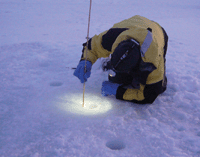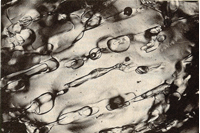Mathematics and Climate Math Awareness Month April 2009
March 21, 2009
Mathematics and Climate, the theme of this year's Mathematics Awareness Month, could hardly be more timely. Or the materials presenting it more compelling. Go to www.mathaware.org/mam/09/ and udge for yourself.
Math Awareness Month is an annual collaborative project of the Joint Policy Board for Mathematics, whose four member societies are the AMS, ASA, MAA, and SIAM. The Math and Climate materials reflect the varied interests of the four societies, and they offer something for a visitor at just about any level. Because one of the main functions is education, the materials---illustrated essays, videos, and references---are pitched roughly at the level of a college student. The authors of a few of the essays, in fact, write about their own recent experiences as undergraduates; their lively reports of far-from-traditional experiences and REU programs should be especially intriguing to student visitors to the site.
For the SIAM community, with a long tradition of interdisciplinary and multidisciplinary activities, the integration of applied and computational math and computer science with materials science, geophysics, biology, and other sciences won't come as a surprise. Still, many will learn of new re-search at the frontiers of and edges between these disciplines, and faculty looking to direct their students to interesting work will find abundant resources. Visitors to the site might be surprised by the range of government agencies, university centers and institutes, and publications devoted to climate change. Like any good report on a field, this one identifies not only research accomplishments but also many open challenges for the research community.
The AMS, the coordinating society for Math Awareness Month 2009, began with the appointment of a well-qualified and -rounded committee: Ken Golden of the University of Utah (chair); Kerry Emanuel, MIT; Inez Fung, UC Berkeley; Margot Gerritsen, Stanford; David Holland, NYU; Jon Huntsman, Jr., governor of Utah; J. David Neelin, UCLA; Mary Lou Zeeman, Bowdoin College, and Jay Zwally, NASA. Some of the committee members also contributed essays. Highlights from selected essays round out this page.

Mention Ken Golden and many readers will (correctly) think "sea ice." They might have heard the talk he gave in January as the SIAM invited speaker at this year's Joint Mathematics Meetings, in which he described his longstanding hands-on experience with sea ice (he's pictured here during a 2007 Antarctic expedition) as a composite material that serves as both "an indicator and an agent of climate change." In 2008 he gave a keynote lecture on the subject at the annual SACNAS meeting. For Mathematics Awareness Month, he and co-authors Elizabeth Hunke (Los Alamos National Laboratory), Cecilia Bitz (University of Washington), and Marika Holland (National Center for Atmospheric Research) joined forces to make a case for the importance of sea ice in the earth's climate system as a prelude to a discussion of modeling considerations and challenges. "Modeling the complex interactions among the oceans, atmosphere, and cryosphere---those portions of earth's surface where water is in solid form---requires a lot of mathematics, computation, and many areas of science," they write. Photo by Jan Lieser, taken in September 2007 during the Sea Ice Physics and Ecosystem Experiment in Antarctica; to determine the permeability of the sea ice he's scrutinizing, Golden measured how quickly water rose in a hole drilled partially through the ice.

Sub-millimeter-scale brine inclusions in sea ice. The illustration, from W. Weeks and A. Assur, appears in the essay of Golden and co-authors. "Sea ice is simply frozen ocean water," they write (as compared with glaciers, icebergs, ice sheets, and other forms of ice that originate on land). "When salt water freezes, the result is a composite of pure ice with inclusions of liquid brine, air pockets, and solid salts." Why that matters quickly becomes clear: "As the temperature of sea ice increases, the porosity or volume fraction of brine increases. The brine inclusions in sea ice host extensive algal and bacterial communities which are essential for supporting life like krill in the polar oceans, which supports fishes, penguins, seals, and Minke whales, and up the food chain to killer whales, leopard seals, and polar bears. The brine microstructure also facilitates the flow of salt water through sea ice, which mediates a broad range of processes, such as the growth and decay of seasonal ice, the evolution of ice pack reflectance, and biomass build-up."

Research Experiences for Undergraduates take many forms. For University of Utah math student Adam Gully, participation in an REU directed by Ken Golden led to a summer in Antarctica as a member of a research expedition. In an essay titled "A Math Student's Journey to Antarctica," Gully recalls his first view of sea ice: "The top of the ocean was about �2 degrees Celsius and ice was starting to form into disks called pancake ice. There were probably millions of these disks surrounding the ship. . . . While the ship was still close enough to the sea ice edge, these perfect waves generated in the nearby open ocean propagated through the pancake ice. Instead of the seemingly chaotic movement that the ship had been undergoing in the open ocean, the ship now moved up and down in a pleasant sinusoidal motion."
The scientists' goal, he continues, "was to collect empirical data to help develop mathematical theories on sea ice and to verify mathematics that had already been developed."

Cumulus clouds over the South Pacific, from the essay "Uncertainty in Climate Predictions," by Douglas Nychka of NCAR, Juan Restrepo of the University of Arizona, and Claudia Tebaldi of Climate Central. The 2007 report of the Intergovernmental Panel on Climate Change, the authors write, identifies uncertainty quantification as "one of the most pressing research issues in determining our overall ability to propose how human activities can be modified to mitigate our effects on natural climate." In their essay, an overview of atmosphere/ocean general circulation modeling is interlaced with a discussion of sources of uncertainty in models. Parameterization, defined as "the technique of representing unresolved processes," such as cloud formation, is cited as both an active area of climate research and, "not surprisingly . . . a key factor in model uncertainty." Also discussed as large sources of uncertainty in the development and application of climate models are initial conditions, boundary conditions, and model structure. Photo from the NCAR Digital Library.

"Imagine you are an engineer working for an oil company on a large field," Margot Gerritsen writes in an essay titled "Mathematics in Energy Production." After several decades of production, the pressure in the reservoir has declined, making it harder to extract the oil from the tiny pore spaces in the reservoir rocks. The company decides to re-pressurize the reservoir by injecting gas (carbon dioxide). You are asked to find the placement of the injection wells that will maximize the production of oil. To do this, you have to figure out how gas and oil and any water in the reservoir will flow and interact. You use reservoir simulators that model the flow and chemical behavior of the fluids. The models consist of thousands and thousands of unknowns and equally large numbers of equations, all strongly coupled and nonlinear.
In the two-dimensional simulation shown, carbon dioxide (yellow) is injected from the left into a reservoir. Preferring the path of least resistance ("high-permeability paths"), the gas "fingers" as it flows through the rock. As it flows, the gas sweeps oil (black) out of the pores and, ultimately, out of the ground.
Gerritsen, who chairs the SIAM Activity Group on Geosciences, was an invited speaker at the group's most recent (2007) conference. See www.siam.org/news/news.php?id=1132 for Barry Cipra's report on the enhanced oil recovery methods she discussed, including miscible gas injection and in situ combustion, along with strategies for geological carbon dioxide sequestration.

